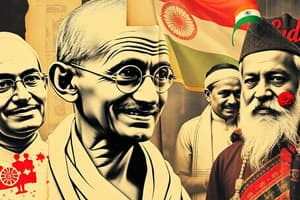Podcast
Questions and Answers
What was the August Movement known for?
What was the August Movement known for?
- Resulted in the formation of political parties
- Led by the Servants of India Society
- Starting with Mahatma Gandhi's 'Do or Die' call (correct)
- Focused on industrial growth
Which organization focused on education, promoting industrial growth, and improving rural conditions during the mass phase?
Which organization focused on education, promoting industrial growth, and improving rural conditions during the mass phase?
- Servants of India Society (correct)
- August Movement
- Indian National Congress
- All-India Congress Committee
What impact did the mass phase of India's national movement have on various groups within India?
What impact did the mass phase of India's national movement have on various groups within India?
- Led to religious conflicts
- Strengthened regional divisions
- Fostered unity among different groups (correct)
- Increased division among ethnic groups
What was a key aspect of the Servants of India Society during the mass phase of the national movement?
What was a key aspect of the Servants of India Society during the mass phase of the national movement?
What was a notable event associated with the August Movement during the mass phase?
What was a notable event associated with the August Movement during the mass phase?
What was a significant outcome of the mass phase of India's national movement?
What was a significant outcome of the mass phase of India's national movement?
What characterizes the mass phase of the Indian national movement?
What characterizes the mass phase of the Indian national movement?
Which philosophy did Mahatma Gandhi advocate for during the Indian national movement?
Which philosophy did Mahatma Gandhi advocate for during the Indian national movement?
What was one of Mahatma Gandhi's key strategies during the Indian national movement?
What was one of Mahatma Gandhi's key strategies during the Indian national movement?
What did the Noncooperation Movement encourage Indians to do?
What did the Noncooperation Movement encourage Indians to do?
During the Indian national movement, what did Gandhi envision for an independent India?
During the Indian national movement, what did Gandhi envision for an independent India?
Which prominent event in 1942 showcased mass civil disobedience against British rule in India?
Which prominent event in 1942 showcased mass civil disobedience against British rule in India?
Flashcards are hidden until you start studying
Study Notes
The Mass Phase of India's National Movement
As colonial rule began to weaken during the early 20th century, Indian citizens mobilized en masse, propelling their country towards independence through collective action, nonviolent resistance, and political organization. This period marked the mass phase of the Indian national movement.
Gandhi and Noncooperation
Mahatma Gandhi emerged as a pivotal figure, advocating for Satyagraha — a philosophy of active, nonviolent civil disobedience aimed at achieving both moral objectives and tangible social changes. One of his key strategies was the Noncooperation Movement, which encouraged Indians to withdraw from British economic, political, and social structures by refusing to work government jobs, to buy foreign goods, and even to attend schools administered by Britain. In addition, thousands of Indians willingly endured imprisonment rather than submit to laws they deemed unjust.
Gandhi also envisioned an independent India where all communities would coexist harmoniously. His vision involved empowering marginalized groups such as women, Dalits, and tribal communities to fully participate in democratic processes.
Civil Disobedience Campaigns
The Quit India Movement of 1942 is another prominent example of mass civil disobedience campaigns against British rule. Led primarily by the Congress Party, this movement prompted widespread strikes, demonstrations, and acts of defiance across the nation, further highlighting public demands for self-rule and freedom. A notable event from this campaign was the August Movement, named because it started with Mahatma Gandhi calling for 'Do or Die' action when addressing the All-India Congress Committee on August 8, 1942.
These movements fostered unity among various ethnic, religious, linguistic, and regional groups within India, ushering in an era of political assertiveness, grassroots activism, and increased participation in political discourse.
Impactful Organizations
Another significant aspect of the mass phase were organizations like the Servants of India Society, founded by Gopala Krishna Gokhale, an influential figure in the earlier phases of the national movement. With branches throughout India, it focused on providing education, promoting industrial growth, and improving rural conditions. Additionally, the formation of political parties and cultural associations led to more organized efforts, enhancing popular support for the causes of independence and self-determination.
In conclusion, the mass phase of India’s national movement represents a critical turning point in history; ordinary people came together to challenge the status quo, demanding change and driving their country towards self-governance. By nurturing a spirit of collaboration, cooperation, and community involvement, these events laid the groundwork for modern-day Indian democracy.
Studying That Suits You
Use AI to generate personalized quizzes and flashcards to suit your learning preferences.




